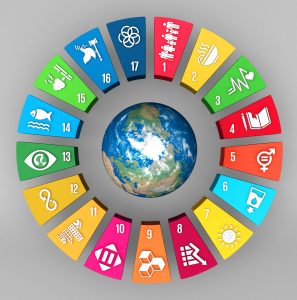History
The term sustainability was already formulated in forestry in 1713. At that time, it described the practice of only felling as much wood in a forest as can grow back again. Later, the term was applied to other economy sectors as well.
What does sustainability mean?
The basic idea is always to use natural resources and energy in such a way that the environment can tolerate the use of resources in the long term and regenerate. This means that only as many natural resources are consumed or used as can grow back or regenerate. Non-renewable raw materials (e.g. metals) should only be mined in quantities that cannot be recovered through recycling and thus kept in the cycle.
The term sustainability is still not clearly and unambiguously defined. Sustainability represents a cross-cutting issue and is associated with a variety of topics. There is widespread agreement on the three fundamental pillars of sustainability: ecology, economy and social issues.
The three pillars of sustainability

Three pillars of sustainability: economy, ecology, social @ Wolfilser_stock.adobe.com
The three pillars of sustainability define what the concept of sustainability is based on and what it consists of: ecology, economy and social issues. These three components are to be considered of equal importance and are mutually dependent.
The first pillar symbolises economic aspects of sustainability. Companies should pursue long-term sustainability strategies. It is perfectly acceptable for companies to make a profit. However, the environment should not be negatively affected and social factors should be developed positively. In addition, the principle can be applied to entire countries: globally, a fairer distribution of value creation should be strived for between countries.
For the ecological pillar, it is demanded that the earth’s resources such as water and raw materials be conserved and that these resources be made permanently available. Raw materials should be as renewable as possible and kept in a cycle. Natural resources also include biodiversity.
The third pillar describes social sustainability. This states that social factors should also influence sustainable action. This begins with human dignity and the fundamental right of everyone to develop according to their own aspirations. It further concerns aspects such as the right to education, racial and gender equality, fair pay, opportunities for advancement, independent courts, etc..

17 UN Sustainable Development Goals @ MintBlak-stock.adobe.com
UN Sustainable Development Goals
In 2015, the United Nations (UN) formulated 17 Sustainable Development Goals (SDGs) to enable all people to live in dignity while preserving the natural foundations of life in the long term. They include economic, ecological and social aspects, such as equitable access to food, health and education. The fight against climate change, access to affordable and clean energy, the protection of ecosystems and sustainable consumption and production are also enshrined in these goals. Many countries around the world are committed to the Sustainable Development Goals, including the German Federal Government in its sustainability strategy.
Sustainable use of innovative materials
In many areas there is high demand for innovative materials with new properties (e.g. battery production, medicine). Often, material development focuses on optimising the respective property and less on sustainability aspects (e.g. conditions during mining of lithium or copper). However, new materials can be designed more sustainably by paying attention to the careful use of resources (e.g. saving energy during production) and closing material cycles (circular economy). For example, conventional petroleum-based plastic can be replaced by other more sustainable materials. On the one hand, these would be materials made from renewable raw materials, and on the other hand, biodegradable materials, since conventional plastic materials only degrade very slowly. To assess the sustainability of innovative materials, the entire life cycle of a material or product is considered. For example, the conditions during the extraction of raw materials or the energy consumption during the further processing of materials are taken into account. Recycling and the reuse of raw materials are of particular importance for sustainable materials.
Sustainability and material safety
The safety of innovative materials for humans and the environment is an important component in assessing their sustainability. This is enshrined in the UN Sustainable Development Goals on Health (3), Industry, Innovation and Infrastructure (9), Sustainable Consumption and Production (12), Life Under Water (14) and Life on Land (15). Only materials and products that do not harm human health and the environment are also sustainable, but on the condition that they also fulfil other sustainability aspects.
 >
>